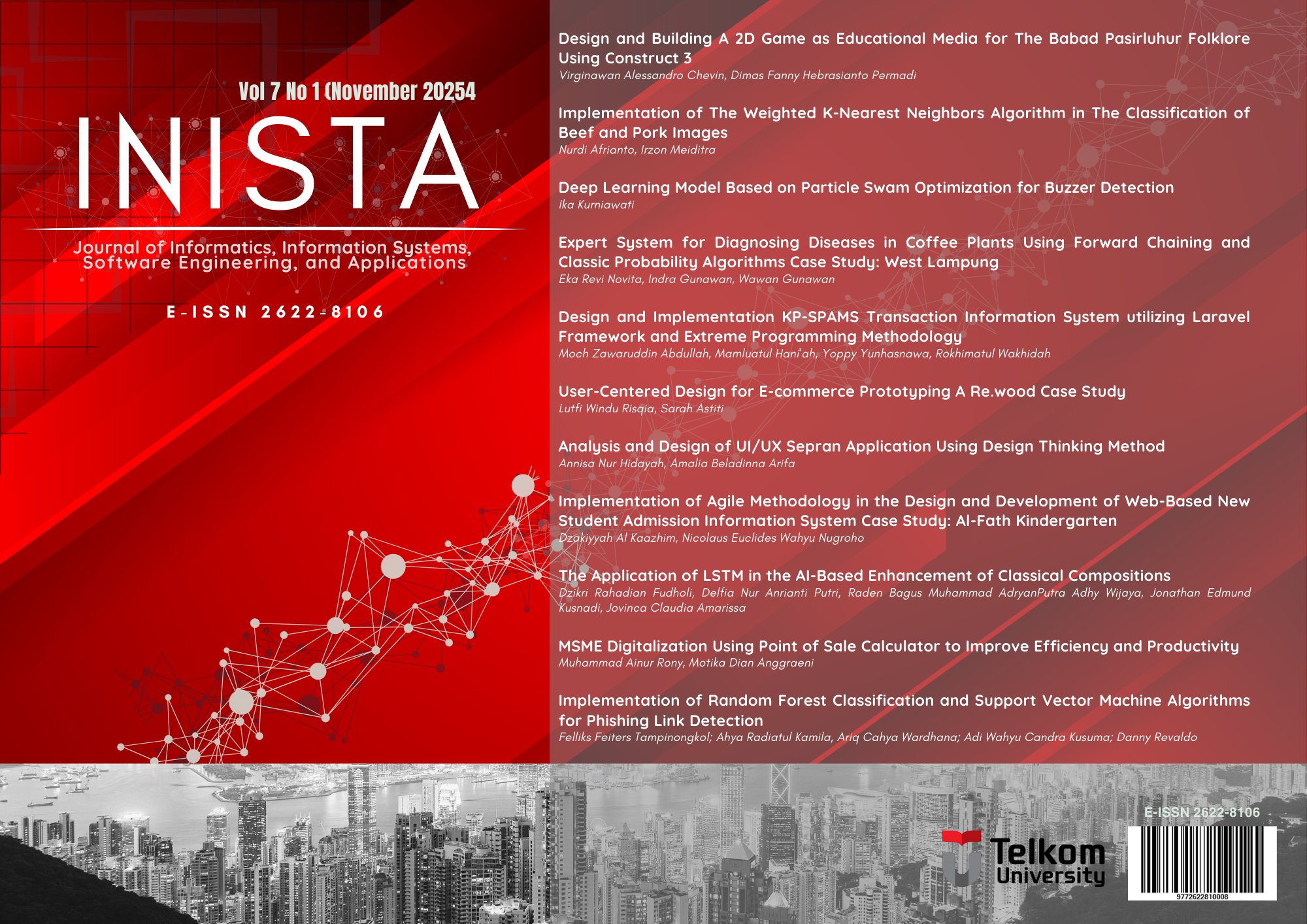Design and Implementation KP-SPAMS Transaction Information System utilizing Laravel Framework and Extreme Programming Methodology
Main Article Content
Abstract
The Community-Based Drinking Water and Sanitation Management Group (KP-SPAMS) oversees the Community-Based Drinking Water and Sanitation Provision Program (PAMSIMAS), which is essential for providing clean water services to rural areas. Nevertheless, KP-SPAMS continues to face challenges related to operational transaction management, such as the documentation of customer data, water usage, invoicing, and financial reporting. This research aims to develop a web-based transaction information system, utilizing the Laravel framework and the Extreme Programming methodology, to meet the specific requirements of KP-SPAMS Sumber Waras located in Ngenep Village, Malang Regency. The Extreme Programming methodology facilitates adaptable and cooperative software development, enabling quick responses to evolving customer requirements. The system's primary functionalities are customer registration, water usage recording, automatic billing, and payment reporting. The implementation results indicate that this system may enhance operational efficiency, accountability, and traceability of all transaction processes in KP-SPAMS, facilitating improved decision-making and superior service quality for the community. User Acceptance Testing results show that 80% of users rated the system positively, with 53.33% agreeing and 26.67% strongly agreeing that the system meets their needs and provides a satisfactory experience. Only 6.67% of responses indicated dissatisfaction, and no respondents strongly disagreed, demonstrating that the system aligns well with user expectations and offers a solid foundation for future improvements.
Article Details

This work is licensed under a Creative Commons Attribution-ShareAlike 4.0 International License.
Authors who publish with this journal agree to the following terms:
- Authors retain copyright and grant the journal right of first publication with the work simultaneously licensed under a Creative Commons Attribution License (CC BY-SA 4.0) that allows others to share the work with an acknowledgement of the work's authorship and initial publication in this journal.
- Authors are able to enter into separate, additional contractual arrangements for the non-exclusive distribution of the journal's published version of the work (e.g., post it to an institutional repository or publish it in a book), with an acknowledgement of its initial publication in this journal.
- Authors are permitted and encouraged to post their work online (e.g., in institutional repositories or on their website) prior to and during the submission process, as it can lead to productive exchanges, as well as earlier and greater citation of published work.
References
[2] R. Hartono, “Strategi Manajemen KPSPAMS Tirta Mulya Dalam Penerapan Iuran Pelanggan Air Minum Untuk Desa Keberlanjutan PAMSIMAS,” J. Adm. Bisnis Nusant., vol. 1, no. 2, pp. 59–66, 2022.
[3] M. N. Isra, M. Latief, and R. H. Dai, “Sistem Informasi Pengelolaan Air Minum pada KP-SPAMS di Desa Molotabu,” Diffus. - J. Syst. Inf. Technol., vol. 4, no. 1, pp. 18–28, 2024.
[4] A. Christian and A. Sastra Dilaga, “RANCANG BANGUN WEBSITE PDAM TIRTA PRABUJAYA KOTA PRABUMULIH,” J. Sist. Inf. dan Komputerisasi Akunt., vol. 02, no. 2, 2018.
[5] D. Karyaningsih, Z. Hakim, A. gilar pratama, F. Teknologi dan Informatika universitas Mathla, and ul Anwar Banten, “Rancang Bangun Sistem Informasi Tagihan Rekening Air pada PDAM Pandeglang,” SITUSTIKA FIKUNMA, vol. 9, no. 1, 2020.
[6] R. S. Wachid and L. A. Muharom, “Penerapan E-Billing System Untuk Meningkatkan Layanan Air Minum di Desa Cumedak Kecamatan Sumberjambe, Jember,” J. Community Dev., vol. 3, no. 2, pp. 243–251, Aug. 2022, doi: 10.47134/comdev.v3i2.91.
[7] H. Ahmadi and M. H. Nasution, “Rancang Bangun System Komputerisasi Penguatan Pelayanan Kelompok Penyelenggara Sanitasi Penyedia Air Minum (KPSPAM ‘DJ-Menteng’) Desa Pendem Kec. Janapria,” J. Inform. dan Teknol., vol. 2, no. 2, pp. 119–126, 2019.
[8] Y. Eka Achyani, E. Arviana, J. Damai No, W. Jati Barat, and J. Selatan, “Sistem Informasi Pendapatan Jasa Pada Koperasi PDAM Tirta Patriot Bekasi,” J. Tek. Komput., vol. 4, no. 1, 2018.
[9] A. B. Almuqsitu, T. Tursina, and A. S. S, “Rancang Bangun Aplikasi Pelayanan Pelanggan PDAM Tirta Kapuas Berbasis Web,” J. Sist. dan Teknol. Inf., vol. 7, no. 1, p. 13, 2019, doi: 10.26418/justin.v7i1.27363.
[10] N. Yadav, D. S. Rajpoot, and S. K. Dhakad, “LARAVEL: A PHP Framework for E-Commerce Website,” Proc. IEEE Int. Conf. Image Inf. Process., vol. 2019-November, pp. 503–508, 2019, doi: 10.1109/ICIIP47207.2019.8985771.
[11] Moch Zawaruddin Abdullah, Mungki Astiningrum, Yuri Ariaynto, Dwi Puspitasari, and Atiqah Nurul Asri, “Rancang Bangun Sistem Informasi Akuntansi Berbasis Website menggunakan Framework Laravel,” J. Sains, Teknol. dan Ind., vol. 18, no. 1, pp. 49–56, 2020.
[12] M. I. Alhari, M. Lubis, and F. Budiman, “Information System Management of Palm Agriculture using Laravel Framework,” in 2022 International Conference on Informatics, Multimedia, Cyber and Information System (ICIMCIS), 2022. doi: 10.1109/ICIMCIS56303.2022.10017918.
[13] M. G. Wonoseto, A. Maulana, and M. Asyari, “Rancang Bangun Aplikasi Pengadaan Barang dan Jasa Universitas Negeri XYZ dengan Metode Extreme Programming,” JISKA (Jurnal Inform. Sunan Kalijaga), vol. 8, no. 3, pp. 186–198, 2023, doi: 10.14421/jiska.2023.8.3.186-198.
[14] D. Prasetyo, A. Utami, and T. G. Laksana, “Website-Based Academic Information System Design Using Extreme Programming Method (Observation Study: State Junior High School 3 Watukumpul),” J. Informatics, Inf. Syst. Softw. Eng. Appl., vol. 6, no. 2, pp. 134–143, 2024, doi: 10.20895/INISTA.V6I2.1214.
[15] M. U. Siregar and H. Musafa, “Rancang Bangun Sistem Informasi Penyediaan Air Minum Dan Sanitasi Berbasis Masyarakat (Pamsimas) Dengan Metode Extreme Programming,” JISKA (Jurnal Inform. Sunan Kalijaga), vol. 4, no. 2, p. 13, 2019, doi: 10.14421/jiska.2019.42-02.
